- Hydrocarbons in the other “Lake Ontario”
- The Golden Age for Satellite Imaging of Pollutants?
- A GLIMPSE of the Milky Way
- Two of the Milky Way's Spiral Arms are Missing!
- Terra/Aqua Satellite Image Reveals Cyclone Nargis Floods
- The Phoenix Has Landed
- Tiny meteorite whiskers with astronomical implications
- Titan's hidden ocean
- Water and Methane in the atmosphere of an extra-solar planet
- Ring around Rhea
- Wet Planetary Birthplace?
- The Cosmic Ray Energetics And Mass (CREAM)
- Balloon Borne Experiment with Superconducting Spectrometer (BESS)
- Advanced Thin Ionization Calorimeter (ATIC)
- Wind blown Mars: Aeolian features seen by HiRISE
- Touch the Invisible Sky: Space images Braille book
- First successful prediction of an extrasolar planet
- Shake and Bake: Did putative primitive particles form on impact?
- Storm report for Jupiter
- Sodium Absorption from an Exoplanetary Atmosphere
- First global 3-D MHD simulations of unstable disk accretion
- Could bacteria survive a trip to/from Mars?
- Asteroid 2007 WD5 May Hit Mars
- A Sulfur Dioxide Climate Feedback on Early Mars
- Sunrise! The Hinode Issue of Science
- A Cold Spot in the Cosmic Background
- Heavy Negative Organic Ions Titan's Upper Atmosphere
- Antarctica at Ten Times the Resolution
- Forests Damaged by Hurricane Katrina Become Major Carbon
- Estimating Hurricane Intensity
- Collision behind extremely luminous super-nova explosion
- Record Fifth Planet Discovered Orbiting Nearby Star
- Most massive stellar-mass black hole
- Belt Of Moonlets In Saturn's Rings
- Rubies and sapphires in the very early universe
- Sampling the Sun
- Older Galaxy Taking Gas From Younger, Forming New Stars
- Observing the Sun from a Balloon at 120,000 feet
- BLAST Movies on the Web
- The Lowest Metallicity Planet Host Star
- Understanding the Rate of Ozone Loss
- Speeding Bullet Star Leaves Enormous Streak Across Sky
- New Class of "Main-Belt" Comets Discovered
- Astronomers Map Out Planetary Danger Zone
- Orphan Stars Found in Long Galaxy Tail
- Scientists Find Ring of Dark Matter
- Dramatic Reduction in Perennial Winter Sea Ice
- 'Lab on a Chip' Successfully Tested in Space
- The Ring-Plane Crossing of Uranus
- NASA Debuts Video of Total Solar Eclipse
- Measuring Landslide Risks From Space
- Oxygen Appeared in Earth's Atmosphere Earlier Than Previously Known
- Amazon Forest Unexpectedly Resilient to Drought
- Successful flyby of Iapetus by the Cassini satellite
- Saturn's Gravitational Fie
- An Asteroid breakup possible source of K/T impactor
56. Hydrocarbons in the other “Lake Ontario”

In the letter “The identification of liquid ethane in Titan's Ontario Lacus” by R. H. Brown et al., in the 31 July 2008 (Vol 454 #7204) issue of the journal Nature presents observations suggesting that Ontario Lacus, a lake-like structure near Titan's south pole, is filled with liquid ethane, among other things. The News and Views piece Planetary science: Organic lakes on Titan by François Raulin puts this discovery of the long searched for liquid hydrocarbons in context. The data is from NASA’s Cassini Spacecraft.
55. The Golden Age for Satellite Imaging of Pollutants?
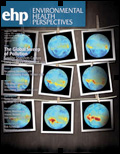
The cover of the August 2008 issue of Environmental Health Perspectives (Volume 116, Number 8) shows NASA satellite images of how carbon monoxide from agricultural fires in South America and Africa crossed the Atlantic Ocean in late summer 2005, mixed, and returned home. The Focus article “The Global Sweep Of Pollution: Satellite Snapshots Capture Long-Distance Movement” describes how satellite data are being used to formulate a clearer picture of the global transport of pollutants. It Includes data from CALIPSO Terra, and other satellites.
54. A GLIMPSE of the Milky Way
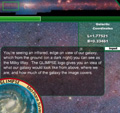
The Galactic Legacy Infrared Mid-Plane Survey Extraordinaire (GLIMPSE) Spitzer team released two multi-gigapixel infrared images of the Milky Way on June 4th at the AAS meeting From this an annotated zoomable version of the images was made available on the web. You can even identify a feature you like and send the link to a friend. The second part of the project is to provide it as a standalone (internet free) version for science centers and libraries which will come later this year. To try it out go to http://www.alienearths.org/glimpse/
53. Two of the Milky Way's Spiral Arms are Missing!
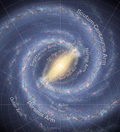
New images from NASA's Spitzer Space Telescope are shedding light on the true structure of the Milky Way, revealing that it has just two major arms of stars instead of the four it was previously thought to possess.
The science team was led by Robert Benjamin of the University of Wisconsin and this project is being presented at the American Astronomical Society meeting in St. Louis. For more information please see the SMD chief scientist’s highlight, see the article at Space.com, or the JPL web release.
52. Terra/Aqua Satellite Image Reveals Cyclone Nargis Floods
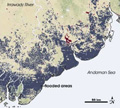
In early May, Cyclone Nargis caused widespread flooding in Myanmar (Burma). Determining the extent of flooding can be difficult; clouds often obscure satellite observations, and muddy-brown floodwaters typically blend in with the surrounding landscape, especially fallow cropland. A standard satellite image can provide an approximation of the flood extent, but not an exact outline. However, multiple sources of information can be combined to provide a better picture of flooded areas. In the image at left, which combines observations taken by NASA’s Terra and Aqua satellites on May 5, 2008, by the Moderate Resolution Imaging Spectroradiometer (MODIS) sensors shows that flooding appears to be more intense in areas with fewer trees. For more information please see the NASA web feature, or the articles at Earth Observatory News and SpaceRef.com.
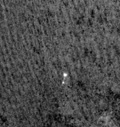
On May 25th shortly after 4:30 pm PST (and curiously also Mars time) the Phoenix Mission landed gracefully on Mars. Named after Phoenix, the mythological bird that rose from the ashes of its ancestor, this Mars mission was named in honor of its predecessor Mars polar lander, which had a similar destination and mission but was lost on entry, descent or landing. This mission which is groundbreaking both literally and figuratively has landed far farther north of the Martian equator around which all prior landers and rovers have touched down. Landing as it does in the Martian equivalent of the Yukon Territories, Phoenix is likely to encounter frost at the surface, and with luck will find water ice and organic molecules below. The image above shows a (HiRISE) image, taken from orbit, of Phoenix descending on a parachute. This is the first time an image has been taken of a spacecraft descending to the surface of Mars. This images can be found at the Phoenix web page, and images of the surface can be found at the image gallery.
50. Tiny meteorite whiskers with astronomical implications
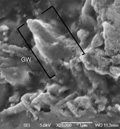
In the report “Graphite Whiskers in CV3 Meteorites” in the journal Science (320, 91 – 93) Fries and Steele propose that graphite whiskers could easily have been launched into interstellar space by bipolar outflows of forming solar systems. Graphite whiskers have been postulated to play a role in the near-infrared (near-IR) dimming of type 1a supernovae, as well as in the thermalization of both the cosmic IR and microwave background and in galactic center dimming between 3 and 9 micrometers. For more information see the Astronomy Perspectives piece “Small-Scale Observations Tell a Cosmological Story” by Philip Bland.
This work was funded by NASA Sample Return Laboratory Instrument and Data Analysis, Astrobiology Science and Technology for Exploring Planets, and Astrobiology Institute programs.
49. Titan's hidden ocean

Years of Cassini observations have allowed Ralph Lorenz and colleagues to show that Titan's rotational period is changing and is different from its orbital period. In their report "Titan's Rotation Reveals an Internal Ocean and Changing Zonal Winds" in the Journal Science (2008) 319, 1649-1651 suggest that an ocean may be hiding beneath Titan's thick atmosphere and icy surface, but other explanations of the observed results cannot yet be ruled out. For more information you can follow the link to the original article, above, read the planetary science perspectives piece "Titan's Hidden Ocean" by Sotin & Tobie, NASA's press release, or one of many online articles including at Scientific American, Space.com, and Sciencedaily.
Dr. Lorenz is supported by the Cassini Data Analysis program.
48. Water and Methane in the atmosphere of an extra-solar planet

In an article accepted in the journal Nature Professor Mark Swain and Gautam Vasisht of Caltech, and Giovanna Tinetti of University College London, UK, report the detection of methane and confirmed an earlier tentative detection of water vapor in the atmosphere of giant planet HD 189733b based on Hubble Space Telescope observations. This marks the first detection of an organic molecules on a planet outside our solar system. However, the authors note that "The giant planet lies too close to its parent star for the methane to signal life." Interestingly they also note that the "combination of water and organic molecules would be a promising one for life if it were found in a less hostile spot than the atmosphere of a searing gas giant." For related materials see the NASA press release, 'Organic molecules found on alien world for first time' by Stephen Battersby for New Scientist online, and for some perspective a recent article in the Washington Post online which is featured on our science matters page.
 In the report "The Dust Halo of Saturn's Largest Icy Moon, Rhea" in the journal Science (319. 1380 -
1384) Jones et al., show that Rhea has an equatorial debris disk that, based on Cassini
measurements, "in the form of grains and boulders up to several decimeters in size." More
information can be found in the Science news of the week piece "Planetary Science: Electron Shadow
Hints at Invisible Rings Around a Moon" by Richard A. Kerr in popular science publications such as
Sky and Telescope, and on news websites like CNN.com.
In the report "The Dust Halo of Saturn's Largest Icy Moon, Rhea" in the journal Science (319. 1380 -
1384) Jones et al., show that Rhea has an equatorial debris disk that, based on Cassini
measurements, "in the form of grains and boulders up to several decimeters in size." More
information can be found in the Science news of the week piece "Planetary Science: Electron Shadow
Hints at Invisible Rings Around a Moon" by Richard A. Kerr in popular science publications such as
Sky and Telescope, and on news websites like CNN.com.
46. Wet Planetary Birthplace?
 Spitzer space telescope observations by John Carr and his team led to the detection of "Organic
Molecules and Water in the Planet Formation Region of Young Circumstellar Disks." In their article
in the journal Science (319. 1504 - 1506) Carr et al., show observations that "suggest that water is
abundant throughout the inner disk and that the disk supports an active organic chemistry." More
information can be found in the Science Perspectives piece "Planetary Science: Observing Our
Origins" by Fred Ciesla and in popular science publications such as science daily.
Spitzer space telescope observations by John Carr and his team led to the detection of "Organic
Molecules and Water in the Planet Formation Region of Young Circumstellar Disks." In their article
in the journal Science (319. 1504 - 1506) Carr et al., show observations that "suggest that water is
abundant throughout the inner disk and that the disk supports an active organic chemistry." More
information can be found in the Science Perspectives piece "Planetary Science: Observing Our
Origins" by Fred Ciesla and in popular science publications such as science daily.
Three recent successful long duration balloon flights over Antarctica. For more information on all three of these flights see the NASA Wallops web release.
45.The Cosmic Ray Energetics And Mass (CREAM)
 The CREAM investigation measures elemental composition and energy spectra of very high-energy energy
(~1010 to > 5 x 1014 eV) cosmic rays with better precision and higher statistics than previous
experiments. It is searching for characteristic changes associated with a limit to particle
acceleration in supernovae. It was launched December 19, 2007, and flew for 28 days. Combined with
two previous flights of 42 days and 28 days, CREAM has now accumulated almost 100 days of exposure.
For more information and images see: http://cosmicray.umd.edu/cream/CREAMflight2007/
The CREAM investigation measures elemental composition and energy spectra of very high-energy energy
(~1010 to > 5 x 1014 eV) cosmic rays with better precision and higher statistics than previous
experiments. It is searching for characteristic changes associated with a limit to particle
acceleration in supernovae. It was launched December 19, 2007, and flew for 28 days. Combined with
two previous flights of 42 days and 28 days, CREAM has now accumulated almost 100 days of exposure.
For more information and images see: http://cosmicray.umd.edu/cream/CREAMflight2007/
44.Balloon Borne Experiment with Superconducting Spectrometer (BESS)
 The BESS will provide definitive measurements of low-energy cosmic-ray antiprotons in solar minimum
conditions, when the sensitivity of the measurements to the possible presence of an exotic source is
greatest. Its precise data will constrain models for dark matter, primordial blackholes and
cosmological antimatter. This second Antarctic flight of BESS, a Japanese - US cooperative project,
was launched on December 23, 2007, and flew for ~ 30 days. For more information see
http://www.kek.jp/intra-e/topics/2007/BESS-Polar_e.html and
http://blog.wired.com/wiredscience/2008/01/balloon-circles.html
The BESS will provide definitive measurements of low-energy cosmic-ray antiprotons in solar minimum
conditions, when the sensitivity of the measurements to the possible presence of an exotic source is
greatest. Its precise data will constrain models for dark matter, primordial blackholes and
cosmological antimatter. This second Antarctic flight of BESS, a Japanese - US cooperative project,
was launched on December 23, 2007, and flew for ~ 30 days. For more information see
http://www.kek.jp/intra-e/topics/2007/BESS-Polar_e.html and
http://blog.wired.com/wiredscience/2008/01/balloon-circles.html
43.Advanced Thin Ionization Calorimeter (ATIC)
 The Advanced Thin Ionization Calorimeter (ATIC) investigation is focusing on cosmic-ray electrons,
the only component for which there is direct evidence of acceleration in supernova remnants.
Electrons are of particular interest because they are subject to synchrotron energy loses that limit
the distance they can travel through space. ATIC also measures high-energy (< 5 x 1010 to ~ 1014 eV)
cosmic-ray proton and helium spectra. This third flight of ATIC was launched December 26, 2007, and
recovered near the South Pole after a 19-day flight. For more information see
http://atic.phys.lsu.edu/aticweb/
The Advanced Thin Ionization Calorimeter (ATIC) investigation is focusing on cosmic-ray electrons,
the only component for which there is direct evidence of acceleration in supernova remnants.
Electrons are of particular interest because they are subject to synchrotron energy loses that limit
the distance they can travel through space. ATIC also measures high-energy (< 5 x 1010 to ~ 1014 eV)
cosmic-ray proton and helium spectra. This third flight of ATIC was launched December 26, 2007, and
recovered near the South Pole after a 19-day flight. For more information see
http://atic.phys.lsu.edu/aticweb/
These science investigations were funded by the Particle Astrophysics element of the Astronomy and Astrophysics Research and Analysis (APRA) research program. Their flights comprised the FY 2008 Antarctic campaign carried out by NASA and the National Science Foundation Office of Polar Programs. Launching and operating three long-duration flights for the first time within a single Antarctic summer achieved a new milestone in scientific observations using balloons.
42.Wind blown Mars: Aeolian features seen by HiRISE
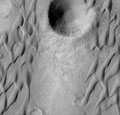 The atmosphere of Mars is less than one-percent the surface pressure of Earth, but even so clear evidence of aeolian processes, including sand dunes and ripples, are shown by Bridges et al., in 'Windy Mars: A dynamic planet as seen by the HiRISE camera' Geophysical Research Letters, 2007 34, CiteID L23205. For more information, and beautiful images, see related articles on marsdaily.com, marssociety.org, and space.com.
The atmosphere of Mars is less than one-percent the surface pressure of Earth, but even so clear evidence of aeolian processes, including sand dunes and ripples, are shown by Bridges et al., in 'Windy Mars: A dynamic planet as seen by the HiRISE camera' Geophysical Research Letters, 2007 34, CiteID L23205. For more information, and beautiful images, see related articles on marsdaily.com, marssociety.org, and space.com.
41. Touch the Invisible Sky: Space images Braille book
 The Braille book 'Touch the Invisible Sky' containing tactile and visual images from three of
NASA's Great Observatories, Hubble Space Telescope, Spitzer Space Telescope and Chandra X-Ray
Observatory was released in a ceremony at the National Federation of the Blind, Baltimore MD, on
January 15, 2008. Using Braille, large print, and tactile images from the three space observatories,
and ground-based telescopes, this book introduces readers of all visual abilities to the concept of
the electromagnetic spectrum. It explores how different observatories complement each others'
findings. Authored by Noreen Grice, Simon Steele, and Doris Daou, this book was created through a
Chandra E/PO supplemental grant and a collaboration between Spitzer Space Telescope, Chandra X-Ray
Observatory, Hubble Space Telescope, and the Origins and Universe Education Forums. It is available
through the National Federation of the Blind, Library of Congress repositories, and a wide range of
public institutions. To learn more about the book you can read
or listen to a story from National Public Radio, visit the web release from NASA.gov (which
includes audio), or read an article
by Dennis O'Brien from the Baltimore Sun.
The Braille book 'Touch the Invisible Sky' containing tactile and visual images from three of
NASA's Great Observatories, Hubble Space Telescope, Spitzer Space Telescope and Chandra X-Ray
Observatory was released in a ceremony at the National Federation of the Blind, Baltimore MD, on
January 15, 2008. Using Braille, large print, and tactile images from the three space observatories,
and ground-based telescopes, this book introduces readers of all visual abilities to the concept of
the electromagnetic spectrum. It explores how different observatories complement each others'
findings. Authored by Noreen Grice, Simon Steele, and Doris Daou, this book was created through a
Chandra E/PO supplemental grant and a collaboration between Spitzer Space Telescope, Chandra X-Ray
Observatory, Hubble Space Telescope, and the Origins and Universe Education Forums. It is available
through the National Federation of the Blind, Library of Congress repositories, and a wide range of
public institutions. To learn more about the book you can read
or listen to a story from National Public Radio, visit the web release from NASA.gov (which
includes audio), or read an article
by Dennis O'Brien from the Baltimore Sun.
40. First successful prediction of an extrasolar planet
 As reported at the 211th meeting of the American Astronomical Society, the recent discovery of the extrasolar planet HD 74156 d nicely confirms the specific prediction of the planet’s existence from earlier work by Barnes et al. (2004, 2005).
Barnes et al.’s “Packed Planetary Systems” model thus has made the
first prediction of a planet’s existence since LeVerrier and Adams 1840
prediction of Neptune and the first prediction of a planet outside our
Solar System. This work has been supported by the NASA Graduate Student
Research Program, the NASA Astrobiology Institute, and the NASA Applied
Information Systems Research Program.
As reported at the 211th meeting of the American Astronomical Society, the recent discovery of the extrasolar planet HD 74156 d nicely confirms the specific prediction of the planet’s existence from earlier work by Barnes et al. (2004, 2005).
Barnes et al.’s “Packed Planetary Systems” model thus has made the
first prediction of a planet’s existence since LeVerrier and Adams 1840
prediction of Neptune and the first prediction of a planet outside our
Solar System. This work has been supported by the NASA Graduate Student
Research Program, the NASA Astrobiology Institute, and the NASA Applied
Information Systems Research Program.
39. Shake and Bake: Did putative primitive particles form on impact?
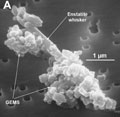 When the Stardust mission returned samples of dust from Comet Wild2 captured in aerogel one of the exciting results was what appeared to be the presence of the enigmatic and primitive GEMS (glass with embedded metal and sulfides) in the aerogel. Ishii et al report in Science 2008 319 447 that 'bulk compositions of GEMS-like material in Stardust tracks differ substantially from GEMS in CP IDPs' [which are believe to come from comets] and that in ‘Stardust tracks, GEMS-like material was created during capture by melting and intermixing of aerogel with crystalline minerals.‘ Further discussion of significance and photo credits can be found in the article Where Has All the Stardust Gone? by Richard Kerr in the geochemistry section of Science’s News of the Week. This work was supported NASA SMD’s Stardust Participating Scientist, Discovery Data Analysis, Sample Return Laboratory Instrument and Data Analysis, and Cosmochemistry programs.
When the Stardust mission returned samples of dust from Comet Wild2 captured in aerogel one of the exciting results was what appeared to be the presence of the enigmatic and primitive GEMS (glass with embedded metal and sulfides) in the aerogel. Ishii et al report in Science 2008 319 447 that 'bulk compositions of GEMS-like material in Stardust tracks differ substantially from GEMS in CP IDPs' [which are believe to come from comets] and that in ‘Stardust tracks, GEMS-like material was created during capture by melting and intermixing of aerogel with crystalline minerals.‘ Further discussion of significance and photo credits can be found in the article Where Has All the Stardust Gone? by Richard Kerr in the geochemistry section of Science’s News of the Week. This work was supported NASA SMD’s Stardust Participating Scientist, Discovery Data Analysis, Sample Return Laboratory Instrument and Data Analysis, and Cosmochemistry programs.
For more information see popular press articles in Spaceflight Now, sciencedaily.com, and physorg.com.
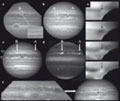 Sánchez-Lavega et al. report in 'Depth of a strong jovian jet from a planetary-scale disturbance driven by storms' Nature (2008) 451, 409-410 how observations of storms and plumes at Jupiter's surface in March of 2007 (see image at left), interpreted with the aid of dynamical models, revealed information about what was happening below. For more information see the News and Views piece 'Planetary science: Under Jupiter's pulsing skin' by Kunio Sayanagi. This work was made possible by HST and IRTF, which are supported by NASA.
Sánchez-Lavega et al. report in 'Depth of a strong jovian jet from a planetary-scale disturbance driven by storms' Nature (2008) 451, 409-410 how observations of storms and plumes at Jupiter's surface in March of 2007 (see image at left), interpreted with the aid of dynamical models, revealed information about what was happening below. For more information see the News and Views piece 'Planetary science: Under Jupiter's pulsing skin' by Kunio Sayanagi. This work was made possible by HST and IRTF, which are supported by NASA.
37. Sodium Absorption from an Exoplanetary Atmosphere
 Seth Redfield and co-authors recently measured sodium absorption From the atmosphere of Exoplanet
HD189733b, a
planet orbiting a neighboring star. The report in the The Astrophysical Journal, Vol
673, L87-L90 on how the sodium was detected in an optical transmission spectrum. This work was
supported by the Science Mission Directorate's TPF Foundation Science and Origins of Solar Systems
programs. For more information on this research see:
Seth Redfield and co-authors recently measured sodium absorption From the atmosphere of Exoplanet
HD189733b, a
planet orbiting a neighboring star. The report in the The Astrophysical Journal, Vol
673, L87-L90 on how the sodium was detected in an optical transmission spectrum. This work was
supported by the Science Mission Directorate's TPF Foundation Science and Origins of Solar Systems
programs. For more information on this research see:
WIRED Blog: Ground-Based Telescope Measures Exoplanet Atmosphere For First Time
36. First global 3-D MHD simulations of unstable disk accretion
 In an upcoming issue of the Astrophysical Journal Romanova,
Kulkarni, & Lovelace present the
first global three-dimensional magnetohydrodynamic simulations. Simulations show that, depending on
the accretion rate, a star may be in the stable or unstable regime of accretion. In the unstable
regime, matter penetrates deep into the magnetosphere through several elongated "tongues" which
deposit matter at random places on the surface of the star, leading to stochastic light curves. There is a preprint available of the peer-reviewed article accepted for publication in a Feb. issue of ApJ Letters. NASA provided high-performance computational
facilities for this work. The research was partially supported by grants from the Science Mission
Directorate's Astrophysics Theory and Fundamental Physics program, as well as grants from NSF.
In an upcoming issue of the Astrophysical Journal Romanova,
Kulkarni, & Lovelace present the
first global three-dimensional magnetohydrodynamic simulations. Simulations show that, depending on
the accretion rate, a star may be in the stable or unstable regime of accretion. In the unstable
regime, matter penetrates deep into the magnetosphere through several elongated "tongues" which
deposit matter at random places on the surface of the star, leading to stochastic light curves. There is a preprint available of the peer-reviewed article accepted for publication in a Feb. issue of ApJ Letters. NASA provided high-performance computational
facilities for this work. The research was partially supported by grants from the Science Mission
Directorate's Astrophysics Theory and Fundamental Physics program, as well as grants from NSF.
35.Could bacteria survive a trip to/from Mars?
 Astrobiologist Wayne Nicholson
will subject bacterial spores to space radiation of the type that
would be encountered on a journey to (or from) Mars. The bacteria will be tested on the EXPOSE
platform the Columbus laboratory module when it is delivered to the International Space Station on
shuttle Atlantis flight STS-122, which is scheduled to launch in early February, 2008. This work
was supported by Science Mission Directorate's Planetary Protection Program, in conjunction with
grants from ESA. For more information see:
Astrobiologist Wayne Nicholson
will subject bacterial spores to space radiation of the type that
would be encountered on a journey to (or from) Mars. The bacteria will be tested on the EXPOSE
platform the Columbus laboratory module when it is delivered to the International Space Station on
shuttle Atlantis flight STS-122, which is scheduled to launch in early February, 2008. This work
was supported by Science Mission Directorate's Planetary Protection Program, in conjunction with
grants from ESA. For more information see:
University of Florida News: Space station experiment to test bacteria hitchhiking to the Red Planet
NASA ESMD: Survivability of Bacillus subtilis Spores After Impact - Mediated Ejection from a Planet
34.Asteroid 2007 WD5 May Hit Mars
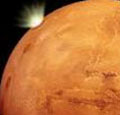 Asteroid 2007 WD5 was first found as part of a search for potential Earth crossing objects, but
it may have a different final destination - Mars. At an approximately 4% chance of hitting the red
planet on Jan. 29, this rock has really attracted a lot of attention. You can read the NASA web
release and read more about it in Time Magazine,
Discovery Channel, and many other
places. For more information, visit the Near-Earth Object site at http://neo.jpl.nasa.gov/.
Asteroid 2007 WD5 was first found as part of a search for potential Earth crossing objects, but
it may have a different final destination - Mars. At an approximately 4% chance of hitting the red
planet on Jan. 29, this rock has really attracted a lot of attention. You can read the NASA web
release and read more about it in Time Magazine,
Discovery Channel, and many other
places. For more information, visit the Near-Earth Object site at http://neo.jpl.nasa.gov/.
Update! The Near Earth Object program now reports that recent measurements of 2007 WD5 from four different observatories essentially rule out the asteroid hitting Mars.
33. A Sulfur Dioxide Climate Feedback on Early Mars

In the December 21st issue of the journal Science Halevy et al., proposed an early martian climate feedback involving SO2, much like that maintained by CO2 on Earth. For more information you can read the full article Halevy et al., (2007) 'A Sulfur Dioxide Climate Feedback on Early Mars' Science, Vol. 318. no. 5858, pp. 1903 - 1907, the Science editor's summary, web press coverage at the BBC, or the web story on the Harvard web page. Itay Halevy, is a Ph.D. candidate in Harvard's Department of Earth and Planetary Sciences, Daniel Schrag, professor of earth and planetary sciences and environmental science and engineering at Harvard, and Maria Zuber, professor of earth, atmospheric, and planetary sciences at MIT. This work was funded by our Planetary Geology and Geophysics Program.
32. Sunrise! The Hinode Issue of Science
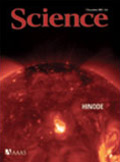
The December 7th Science is the special issue devoted to Hinode. It includes many articles funded in part by NASA research grants and contracts including Pontieu et al "Chromospheric Alfvénic Waves Strong Enough to Power the Solar Wind" Cirtain et.al., "Evidence for Alfvén Waves in Solar X-ray Jets," Reale et.al., "Fine Thermal Structure of a Coronal Active Region," Sakao et.al., "Continuous Plasma Outflows from the Edge of a Solar Active Region as a Possible Source of Solar Wind," and Aulanier et.al., "Slipping Magnetic Reconnection in Coronal Loops." Hinode is a Japanese mission that was developed, launched, and operated by ISAS/JAXA, in partnership with NASA and many other institutions and nations, see any of the cited papers for more information.
31. A Cold Spot in the Cosmic Background
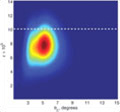
In Cruz et.al., (2007) "A Cosmic Microwave Background Feature Consistent with a Cosmic Texture"
Science 318 1612 an international team of scientists argue that a cold spot recently seen the
microwave microwave background is an indication of "...defects in the very early universe..." For more
information see also Brandenberger's perspectives piece "A Texture in the Sky?" This work used the
Legacy Archive for Microwave Background Data Analysis (LAMBDA), which is supported by NASA SMD.
30. Heavy Negative Organic Ions Titan's Upper Atmosphere

A study analyzing data gathered by the Cassini spacecraft have confirmed the presence of heavy negative ions in the upper regions of Titan's atmosphere. These particles may act as organic building blocks for even more complicated molecules. The team was led by Professor Andrew Coates at University College London. The citation for the paper is Coates et al., (2007) "Ionospheric electrons in Titan's tail: Plasma structure during the Cassini T9 encounter" Geophysical Research Letters, 34, CiteID L24S05.
29. Antarctica at Ten Times the Resolution

A team of researchers from NASA, the NSF, the USGS and the British Antarctic Survey recently unveiled a newly completed map of Antarctica today that is expected to revolutionize research of the continent's frozen landscape. The online digital map of Antarctica is based images captured by the Landsat 7 satellite, which was built by NASA and launched in 1999. They can be found at http://lima.usgs.gov/ Over 1,100 photos were digitally compiled to create a single, nearly cloudless image. This "scientifically accurate mosaic map" has a resolution 10 times greater than previously available images. The project was conceived by Robert Bindschadler of NASA Goddard. He and NASA colleagues selected the images that make up the mosaic and developed new techniques to interpret the image data tailored to the project.
ABC News: Antarctica in High-Def
BBC News: White Continent in its full glory
28. Forests Damaged by Hurricane Katrina Become Major Carbon Source
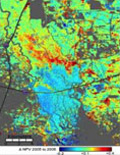 In a recent (Nov. 16th) issue of the journal Science Jeffrey Chambers of Tulane University and his co-authors quantify Hurricane Katrina's impact on Gulf Coast forests by linking ecological field investigations, Landsat and MODIS image analyses, and empirically-based models. They write that "Spatially explicit forest disturbance maps coupled with extrapolation models predicted mortality and severe structural damage to ~320 million large trees totaling ... 60-100% of the net annual U.S. forest tree carbon sink." The full citation and link for the paper is Chambers, Fisher, Zeng, Chapman, Baker, and Hurtt "Hurricane Katrina's Carbon Footprint on U.S. Gulf Coast Forests" Science 2007 318, 1107." You can read more about this work at NASA's earth observatory news archive, and or read the NASA web feature. This work was made possible in part thanks to NASA's Large-scale Biosphere Atmosphere experiment in Amazonia.
In a recent (Nov. 16th) issue of the journal Science Jeffrey Chambers of Tulane University and his co-authors quantify Hurricane Katrina's impact on Gulf Coast forests by linking ecological field investigations, Landsat and MODIS image analyses, and empirically-based models. They write that "Spatially explicit forest disturbance maps coupled with extrapolation models predicted mortality and severe structural damage to ~320 million large trees totaling ... 60-100% of the net annual U.S. forest tree carbon sink." The full citation and link for the paper is Chambers, Fisher, Zeng, Chapman, Baker, and Hurtt "Hurricane Katrina's Carbon Footprint on U.S. Gulf Coast Forests" Science 2007 318, 1107." You can read more about this work at NASA's earth observatory news archive, and or read the NASA web feature. This work was made possible in part thanks to NASA's Large-scale Biosphere Atmosphere experiment in Amazonia.
27. Estimating Hurricane Intensity
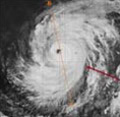 Zhengzhao "Johnny" Luo and co-authors report in the September issue of Geoscience and Remote Sensing
Letters report on the use of CloudSat and MODIS data for estimating hurricane intensity. Their new
method for estimating the intensity of storms from space could improve disaster preparedness and
recovery efforts.
Zhengzhao "Johnny" Luo and co-authors report in the September issue of Geoscience and Remote Sensing
Letters report on the use of CloudSat and MODIS data for estimating hurricane intensity. Their new
method for estimating the intensity of storms from space could improve disaster preparedness and
recovery efforts.
For more information see the NASA and JPL web releases at http://eospso.gsfc.nasa.gov/newsroom/viewStory.php?id=809 and http://www.jpl.nasa.gov/news/news.cfm?release=2007-125
26. Collision behind extremely luminous super-nova explosion
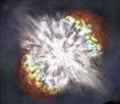 A pair of papers by Zwart & van den Heuvel, and Woosley, Blinnikov & Heger in the current issue of
Nature both propose that collision is the cause of the supernova 10 times brighter than any previous
blast. The latter paper 'Pulsational pair instability as an explanation for the most luminous
supernovae' Nature (15 November 2007) 450, 390-392 was based on work supported by NASA.
A pair of papers by Zwart & van den Heuvel, and Woosley, Blinnikov & Heger in the current issue of
Nature both propose that collision is the cause of the supernova 10 times brighter than any previous
blast. The latter paper 'Pulsational pair instability as an explanation for the most luminous
supernovae' Nature (15 November 2007) 450, 390-392 was based on work supported by NASA.
Science Now: Flashes of Insight Into Mondo Supernova?
Discovery News: Ka-Boom! Blazingly Bright Star Blasts Explained
NASA Press Release: NASA's Chandra Sees Brightest Supernova Ever
25. Record Fifth Planet Discovered Orbiting Nearby Star
 A research team led by Debra Fischer of San
Francisco State University has discovered a fifth planet orbiting 55 Cancri. The fifth planet was
discovered after careful observations using the Shane Telescope at Lick Observatory and the W.M.
Keck Observatory on Mauna Kea, Hawaii. The planet is 45 times as massive as the Earth and completes
one orbit every 260 days. The planet is the fourth from the star and resides in the "habitable
zone," where the temperature would permit liquid water to pool at the surface. 55 Cancri now holds
the record for the number of confirmed extrasolar planets orbiting around it in a planetary system.
This research was supported by NASA's Solar System Origins Program and the National Science
Foundation. More information can be found at:
A research team led by Debra Fischer of San
Francisco State University has discovered a fifth planet orbiting 55 Cancri. The fifth planet was
discovered after careful observations using the Shane Telescope at Lick Observatory and the W.M.
Keck Observatory on Mauna Kea, Hawaii. The planet is 45 times as massive as the Earth and completes
one orbit every 260 days. The planet is the fourth from the star and resides in the "habitable
zone," where the temperature would permit liquid water to pool at the surface. 55 Cancri now holds
the record for the number of confirmed extrasolar planets orbiting around it in a planetary system.
This research was supported by NASA's Solar System Origins Program and the National Science
Foundation. More information can be found at:
The Astrophysical Journal: Five Planets Orbiting 55 Cancri
Popular press coverage can be found at:
Washington Post: A Distant Solar System Has Five Planets
New York Times: A Planetary System That Looks Familiar
USA Today: Astronomers discover 5-planet system orbiting star
Scientific American: Record Fifth Planet Discovered Around Distant Star
24. Most massive stellar-mass black hole
 In the Nov 1st issue of ApJ letters Prestwich et al report on the detection of "...the most massive
stellar-mass black hole known. We further show that the observed period is inconsistent with Roche
lobe overflow, suggesting that the binary is detached and that the black hole is accreting the wind
of the Wolf-Rayet star." Full citation to the article and link:
Prestwich et al., (2007) The Orbital
Period of the Wolf-Rayet Binary IC 10 X-1: Dynamic Evidence that the Compact Object Is a Black Hole.
Astrophysical Journal, letters 669, L21-L24.
In the Nov 1st issue of ApJ letters Prestwich et al report on the detection of "...the most massive
stellar-mass black hole known. We further show that the observed period is inconsistent with Roche
lobe overflow, suggesting that the binary is detached and that the black hole is accreting the wind
of the Wolf-Rayet star." Full citation to the article and link:
Prestwich et al., (2007) The Orbital
Period of the Wolf-Rayet Binary IC 10 X-1: Dynamic Evidence that the Compact Object Is a Black Hole.
Astrophysical Journal, letters 669, L21-L24.
Space.com: Massive Stellar Black Hole Smashes Record
23. Belt Of Moonlets In Saturn's Rings
 "Propeller features" in Saturn's A ring indicating moonlets 60-140 m in diameter have been reported
in a recent issue of the journal Nature based on Cassini images. The full citation for the Article
is: Miodrag Sremcevic, J¸rgen Schmidt, Heikki Salo, Martin Seib, Frank Spahn & Nicole Albers (2007)
'A belt of moonlets in Saturn's A ring' Nature 449, 947-1088.
"Propeller features" in Saturn's A ring indicating moonlets 60-140 m in diameter have been reported
in a recent issue of the journal Nature based on Cassini images. The full citation for the Article
is: Miodrag Sremcevic, J¸rgen Schmidt, Heikki Salo, Martin Seib, Frank Spahn & Nicole Albers (2007)
'A belt of moonlets in Saturn's A ring' Nature 449, 947-1088.
For a distillation see the editors summary 'Propelled to prominence'
National Geographic: Moonlet Study Sheds Light on Origins of Saturn's Rings
Space.com: More Strange Holes Found in Saturn's Rings
22. Rubies and sapphires in the very early universe
 Ciska Markwick-Kemper of the University of Manchester, U.K., and co-authors Gallagher, Hines, and
Bouwman reported in the October 2 issue of ApJ the detection of microscopic mineral grains based on
mid-infrared spectra from the Spitzer Space Telescope. The observed minerals included the form of
aluminum oxide called corundum, which is also the base of ruby and sapphire. The full citation is
Markwick-Kemper et al (2007) "Dust in the Wind: Crystalline Silicates, Corundum, and Periclase in PG
2112+059" The Astrophysical Journal, 668: L107-L110.
Ciska Markwick-Kemper of the University of Manchester, U.K., and co-authors Gallagher, Hines, and
Bouwman reported in the October 2 issue of ApJ the detection of microscopic mineral grains based on
mid-infrared spectra from the Spitzer Space Telescope. The observed minerals included the form of
aluminum oxide called corundum, which is also the base of ruby and sapphire. The full citation is
Markwick-Kemper et al (2007) "Dust in the Wind: Crystalline Silicates, Corundum, and Periclase in PG
2112+059" The Astrophysical Journal, 668: L107-L110.
For more information see Science magazine's News of the Week from the Oct 19th issue and the JPL press release.
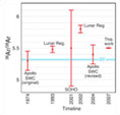 Alex Meshik of Washington University and co-authors report in the October 19th issue of Science a
constraint on Ne and Ar isotopic fractionation between the Sun and the solar wind based on analyses
of Genesis mission data.
Alex Meshik of Washington University and co-authors report in the October 19th issue of Science a
constraint on Ne and Ar isotopic fractionation between the Sun and the solar wind based on analyses
of Genesis mission data.
The full citation for the Article is Meshik et al., (2007) "Constraints on Neon and Argon Isotopic Fractionation in Solar Wind" Science, 318, 433-435
ScienceMag.org Perspectives: Sampling the Sun
20. Older Galaxy Taking Gas From Younger, Forming New Stars
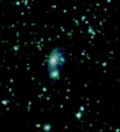 Patrick Ogle of NASA's Spitzer Science Center at the California Institute of Technology, and
co-authors reported in a recent issue of the Astrophysical Journal on the galaxy 3C 326 North. "We
may be viewing the larger galaxy in a rare, brief stage of its reincarnation from an old galaxy to a
youthful one studded with brilliant stars."
Patrick Ogle of NASA's Spitzer Science Center at the California Institute of Technology, and
co-authors reported in a recent issue of the Astrophysical Journal on the galaxy 3C 326 North. "We
may be viewing the larger galaxy in a rare, brief stage of its reincarnation from an old galaxy to a
youthful one studded with brilliant stars."
Links to the original peer reviewed article can be found at: Ogle, Antonucci, Appleton & Whysong (2007) Shocked Molecular Hydrogen in the 3C 326 Radio Galaxy System The Astrophysical Journal, 668, 699-707.
For more information see the article at space.com or listen to a podcast
Balloon Highlights:
19. Observing the Sun from a Balloon at 120,000 feet
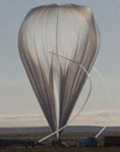 Jack Fox at the National Center for Atmospheric Research (NCAR) and colleagues performed a test
flight of a balloon carrying a solar telescope to 120,000 feet over Fort Sumner, N.M. on Oct 3rd.
Fox and his team were successful in collecting data and demonstrated such studies can be performed
less expensively than by through satellite and spacecraft missions. This work was funded by NASA's
Heliospheric Physics program.
Jack Fox at the National Center for Atmospheric Research (NCAR) and colleagues performed a test
flight of a balloon carrying a solar telescope to 120,000 feet over Fort Sumner, N.M. on Oct 3rd.
Fox and his team were successful in collecting data and demonstrated such studies can be performed
less expensively than by through satellite and spacecraft missions. This work was funded by NASA's
Heliospheric Physics program.
The Denver Post: Balloon test flight hailed
New Scientist Online: Giant balloon to loft world's largest solar telescope
 Balloon-borne, large aperture, sub-millimeter telescope (BLAST) is observing in sub-millimeter
wavelengths to observe the birth of stars in some of the most ancient galaxies in the Universe.
Movies and materials on the web tell the story of the international team of astrophysicists as they
launch this multi-million dollar telescope on a NASA high-altitude balloon.
Balloon-borne, large aperture, sub-millimeter telescope (BLAST) is observing in sub-millimeter
wavelengths to observe the birth of stars in some of the most ancient galaxies in the Universe.
Movies and materials on the web tell the story of the international team of astrophysicists as they
launch this multi-million dollar telescope on a NASA high-altitude balloon.
Their journey to discover thousands of early galaxies takes them from the Arctic to the Antarctic. This work was funded by NASA's Astrophysics Division. You can read more about this project at the CBC news web page
17. The Lowest Metallicity Planet Host Star
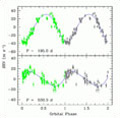 University of Texas at Austin astronomers William Cochran and Michael Endl, working with graduate
students Robert Wittenmyer and Jacob Bean, have used the 9.2-meter Hobby-Eberly Telescope (HET) at
McDonald Observatory to discover a system of two Jupiter-like planets orbiting HD 155358 a star
whose composition might rule out planet formation.
University of Texas at Austin astronomers William Cochran and Michael Endl, working with graduate
students Robert Wittenmyer and Jacob Bean, have used the 9.2-meter Hobby-Eberly Telescope (HET) at
McDonald Observatory to discover a system of two Jupiter-like planets orbiting HD 155358 a star
whose composition might rule out planet formation.
Or read a press release at the McDonald observatory web site.
This work was supported by NASA's Origins of the Solar System program.
16. Understanding the Rate of Ozone Loss
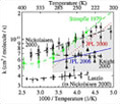 The HOCl (hypocholorous acid) cycle is one of the main halogen catalytic cycles for ozone loss in
the mid-latitude lower stratosphere, but there remains uncertainty at the rate at which this cycle
occurs. A team led by Laurie Kovalenko at JPL has compared vertical profiles of stratospheric HOCl
with photochemical models to show that the occurrence of HOCl is more prevalent than the models
predict. This discrepancy suggests that the current models may underestimate, by up to a factor of
two, the catalytic loss of ozone. This work was supported by the NASA Upper Atmosphere Research
Program. More information can be found at:
The HOCl (hypocholorous acid) cycle is one of the main halogen catalytic cycles for ozone loss in
the mid-latitude lower stratosphere, but there remains uncertainty at the rate at which this cycle
occurs. A team led by Laurie Kovalenko at JPL has compared vertical profiles of stratospheric HOCl
with photochemical models to show that the occurrence of HOCl is more prevalent than the models
predict. This discrepancy suggests that the current models may underestimate, by up to a factor of
two, the catalytic loss of ozone. This work was supported by the NASA Upper Atmosphere Research
Program. More information can be found at:
Kovalenko, L. J., et al. (2007), Observed and modeled HOCl profiles in the midlatitude stratosphere: Implication for ozone loss, Geophys. Res. Lett., 34, L19801, doi:10.1029/2007GL031100.
15. Speeding Bullet Star Leaves Enormous Streak Across Sky
 Christopher Martin of Caltech and his team using NASA's Galaxy Evolution Explorer have spotted a
surprisingly long comet-like tail behind a star streaking through space at supersonic speeds. The
star, named Mira after the Latin word for "wonderful," has been known to astronomers since ancient
times. It is a fast-moving, older red giant star that is shedding massive amounts of surface
material and leaving that material in its wake. The result is an observable tail 13 light years long
and representing material that Mira has thrown off over the past 30,000 years. Astronomers believe
that Mira's tail offers a unique opportunity to study how stars like our sun die and ultimately seed
new solar systems.
Christopher Martin of Caltech and his team using NASA's Galaxy Evolution Explorer have spotted a
surprisingly long comet-like tail behind a star streaking through space at supersonic speeds. The
star, named Mira after the Latin word for "wonderful," has been known to astronomers since ancient
times. It is a fast-moving, older red giant star that is shedding massive amounts of surface
material and leaving that material in its wake. The result is an observable tail 13 light years long
and representing material that Mira has thrown off over the past 30,000 years. Astronomers believe
that Mira's tail offers a unique opportunity to study how stars like our sun die and ultimately seed
new solar systems.
Martin et al., "A turbulent wake as a tracer of 30,000 years of Mira's mass loss history. " Nature 448, 780 - 783 (16 Aug 2007).
NASA Press Release
Multimedia Feature
14. New Class of "Main-Belt" Comets Discovered
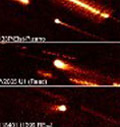 Henry Hsieh and David Jewitt of the University of Hawaii have discovered a new group of comets,
so-called "main-belt comets" that have asteroid-like orbits and appear to have formed in the inner
solar system. This discovery suggests that asteroids and comets are much more closely related than
previously through and also supports the idea that the main asteroid belt could be a major source of
Earth's present-day water. This work was supported by the NASA Planetary Astronomy Program.
Henry Hsieh and David Jewitt of the University of Hawaii have discovered a new group of comets,
so-called "main-belt comets" that have asteroid-like orbits and appear to have formed in the inner
solar system. This discovery suggests that asteroids and comets are much more closely related than
previously through and also supports the idea that the main asteroid belt could be a major source of
Earth's present-day water. This work was supported by the NASA Planetary Astronomy Program.
Images of the three known main-belt comets (at center of each panel above) were taken with the UH 2.2-meter telescope by H. Hsieh and D. Jewitt (Univ. Hawaii). Other objects shown are stars and galaxies smeared by the motion of the telescope while tracking each comet.
Link to the article Hsieh and Jewitt "A Population of Comets in the Main Asteroid Belt" Science 312. 561 - 563
Perspectives: "Ice Among the Rocks" by Alan Fitzsimmons
13. Astronomers Map Out Planetary Danger Zone
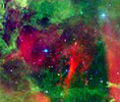 Zoltan Balog et al., reported the first maps of so-called planetary "danger zones." These are areas
where winds and radiation from super hot stars can strip other young, cooler stars like our sun of
their planet-forming materials. The results show that cooler stars are safe as long as they lie
beyond about 1.6 light-years, or nearly 10 trillion miles, of any hot stars. But cooler stars inside
the zone are likely to see their potential planets boiled off into space.
Zoltan Balog et al., reported the first maps of so-called planetary "danger zones." These are areas
where winds and radiation from super hot stars can strip other young, cooler stars like our sun of
their planet-forming materials. The results show that cooler stars are safe as long as they lie
beyond about 1.6 light-years, or nearly 10 trillion miles, of any hot stars. But cooler stars inside
the zone are likely to see their potential planets boiled off into space.
Article: Balog et al., "Spitzer/IRAC-MIPS Survey of NGC 2244: Protostellar Disk Survival in the Vicinity of Hot Stars" - The Astrophysical Journal, 660, 1532-1540
12. Orphan Stars Found in Long Galaxy Tail
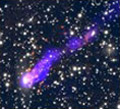 Ming Sun of Michigan State University and his co-authors have found a long tail of gas that extends
well outside its parent galaxy using NASA's Chandra X-ray Observatory. The observations also
indicate that the gas in the tail has formed millions of stars. Because the large amounts of gas and
dust needed to form stars are typically found only within galaxies, astronomers have previously
thought it unlikely that large numbers of stars would form outside a galaxy. This discovery suggests
that such "orphan" stars may be much more prevalent than previously thought.
Ming Sun of Michigan State University and his co-authors have found a long tail of gas that extends
well outside its parent galaxy using NASA's Chandra X-ray Observatory. The observations also
indicate that the gas in the tail has formed millions of stars. Because the large amounts of gas and
dust needed to form stars are typically found only within galaxies, astronomers have previously
thought it unlikely that large numbers of stars would form outside a galaxy. This discovery suggests
that such "orphan" stars may be much more prevalent than previously thought.
Sun, Donahue, & Voit, "Hα tail, intracluster HII regions and star-formation: ESO137-001 in Abell 3627" ApJ eprint arXiv:0706.1220, to appear in the December 10th issue of The Astrophysical Journal
11. Scientists Find Ring of Dark Matter
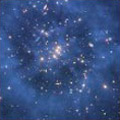 James Jee of Johns Hopkins University and NASA's Hubble Space
Telescope have discovered a ghostly ring of dark matter that formed long ago during a titanic
collision between two massive galaxy clusters. The ring's discovery is among the strongest evidence
yet that dark matter exists. Astronomers have long suspected the existence of the invisible
substance as the source of additional gravity that holds together galaxy clusters. Such clusters
would fly apart if they relied only on the gravity from their visible stars. Although astronomers
don't know what dark matter is made of, they hypothesize that it is a type of elementary particle
that pervades the universe.
James Jee of Johns Hopkins University and NASA's Hubble Space
Telescope have discovered a ghostly ring of dark matter that formed long ago during a titanic
collision between two massive galaxy clusters. The ring's discovery is among the strongest evidence
yet that dark matter exists. Astronomers have long suspected the existence of the invisible
substance as the source of additional gravity that holds together galaxy clusters. Such clusters
would fly apart if they relied only on the gravity from their visible stars. Although astronomers
don't know what dark matter is made of, they hypothesize that it is a type of elementary particle
that pervades the universe.
Article: By Jee et al "Discovery of a Ringlike Dark Matter Structure in the Core of the Galaxy Cluster Cl 0024+17" The Astrophysical Journal, 2007, 661, 728-749.
10. Dramatic Reduction in Perennial Winter Sea Ice
 A research team led by Son Nghiem of NASA's Jet Propulsion Laboratory has observed as 23% loss over
two years in the extent of the Arctic's year-round sea ice cover. In addition, less perennial ice
was observed in March 2007 than ever before. This data was obtained using NASA's QuikScat satellite,
which is able to resolve different types of ice, combined with a computing model based on over 50
years of in situ, buoy-based, measurements of sea ice movement. This research was supported by
NASA's Cryospheric Sciences Program, NOAA, and NSF. More information can be found at:
A research team led by Son Nghiem of NASA's Jet Propulsion Laboratory has observed as 23% loss over
two years in the extent of the Arctic's year-round sea ice cover. In addition, less perennial ice
was observed in March 2007 than ever before. This data was obtained using NASA's QuikScat satellite,
which is able to resolve different types of ice, combined with a computing model based on over 50
years of in situ, buoy-based, measurements of sea ice movement. This research was supported by
NASA's Cryospheric Sciences Program, NOAA, and NSF. More information can be found at:
Nghiem et al., (2007), Rapid reduction of Arctic perennial sea ice, Geophys. Res. Lett., 34, L19504, doi:10.1029/2007GL031138.
New York Times: Arctic Melt Unnerves the Experts
9. 'Lab on a Chip' Successfully Tested in Space
 Astronauts on board the International Space Station successfully tested the NASA-developed
Lab-On-a-Chip Application Development-Portable Test System (LOCAD-PTS). Certain microorganisms can
cause spacecraft systems to degrade or cause human health problems, so the ability to rapidly
identify them while in space is a critical capability for future crews on lunar and Mars missions.
At present, the LOCAD-PTS is able to detect the present of specific bacteria. Work will continue on
the system so that it is able to detect a wider range of microorganisms. As the system advances, it
may be used to detect life on Mars. Work on the LOCAD-PTS was supported by NASA's Planetary
Protection and Astrobiology Programs.
Astronauts on board the International Space Station successfully tested the NASA-developed
Lab-On-a-Chip Application Development-Portable Test System (LOCAD-PTS). Certain microorganisms can
cause spacecraft systems to degrade or cause human health problems, so the ability to rapidly
identify them while in space is a critical capability for future crews on lunar and Mars missions.
At present, the LOCAD-PTS is able to detect the present of specific bacteria. Work will continue on
the system so that it is able to detect a wider range of microorganisms. As the system advances, it
may be used to detect life on Mars. Work on the LOCAD-PTS was supported by NASA's Planetary
Protection and Astrobiology Programs.
More information can be found at: http://locad.nasa.gov/
8. The Ring-Plane Crossing of Uranus

Keck images* of Uranus in 2007 show a rare side view of the rings.
Such ring-plane crossings occur every 42 years; the last-in 1965-was
prior to the rings' 1977 discovery
*Includes NASA Keck observations
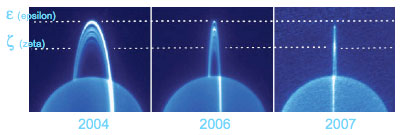
Published in Science 2007 (28 September), 317, 1888 "The Dark Side of the Rings of Uranus," by I. de Pater, H. B. Hammel, M. Showalter, and M. van Dam
- Keck images show dust permeating the ring system, but the dust is not correlated with known narrow rings or with embedded dust belts imaged by Voyager
- Optically-thick rings like ε disappear due to inter-particle shadowing; optically-thin rings like ζ brighten
- Keck results suggest variations occur on much larger scales and more rapidly than expected
7. NASA Debuts Video of Total Solar Eclipse
 A NASA-led scientific expedition traveled to Tripoli to study a total solar eclipse on March 29,
2006. This eclipse provided observers with a unique opportunity to observe the Sun's corona because
it lasted more than four minutes at the center of its path, more than double the typical observing
time. A documentary of this international observing effort is now available, highlighting the
scientific and political interactions experienced by members of the expedition. This work was
funded and coordinated by NASA's Heliophysics Division within the Science Mission Directorate and
the Goddard Space Flight Center, as well as the U.S. Department of State. You can view the
documentary at NASA : Path of Totality: The Movie
A NASA-led scientific expedition traveled to Tripoli to study a total solar eclipse on March 29,
2006. This eclipse provided observers with a unique opportunity to observe the Sun's corona because
it lasted more than four minutes at the center of its path, more than double the typical observing
time. A documentary of this international observing effort is now available, highlighting the
scientific and political interactions experienced by members of the expedition. This work was
funded and coordinated by NASA's Heliophysics Division within the Science Mission Directorate and
the Goddard Space Flight Center, as well as the U.S. Department of State. You can view the
documentary at NASA : Path of Totality: The Movie
6. Measuring Landslide Risks From Space
 Yang Hong, Robert Adler, and George Huffman of NASA's Goddard Space Flight Center have a recent
article, "Satellite Remote Sensing for Global Landslide Monitoring" that shows how topographic and
precipitation data can be used to identify regions of greatest susceptibility to landslides. This
information has the potential to improve landslide modeling and forecasting, useful for disaster
prevention in landslide-prone regions. This work was supported by NASA's Applied Science program
and the Precipitation Measuring Missions (PMM) program (TRMM/GPM). For more information, see:
Yang Hong, Robert Adler, and George Huffman of NASA's Goddard Space Flight Center have a recent
article, "Satellite Remote Sensing for Global Landslide Monitoring" that shows how topographic and
precipitation data can be used to identify regions of greatest susceptibility to landslides. This
information has the potential to improve landslide modeling and forecasting, useful for disaster
prevention in landslide-prone regions. This work was supported by NASA's Applied Science program
and the Precipitation Measuring Missions (PMM) program (TRMM/GPM). For more information, see:
http://trmm.gsfc.nasa.gov/publications_dir/potential_landslide.html
and
The American Geophysical Union EOS Transactions (requires subscription)
5. Oxygen Appeared in Earth's Atmosphere Earlier Than Previously Known
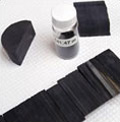 Research teams led by Ariel Anbar and Alan Kaufman have found that trace amounts of oxygen appeared
in the Earth's atmosphere between 2.3 and 2.4 billion years ago, 50 to 100 million years before the
"Great Oxidation Event." By analyzing trace metals and isotopes in core samples dating to just
before the major rise of atmospheric oxygen, the teams found evidence of a small, but significant,
amount of oxygen in the oceans and atmosphere at a time when oxygen was not expected to be present.
This work was funded by the NASA Astrobiology Institute and the National Science Foundation.
Research teams led by Ariel Anbar and Alan Kaufman have found that trace amounts of oxygen appeared
in the Earth's atmosphere between 2.3 and 2.4 billion years ago, 50 to 100 million years before the
"Great Oxidation Event." By analyzing trace metals and isotopes in core samples dating to just
before the major rise of atmospheric oxygen, the teams found evidence of a small, but significant,
amount of oxygen in the oceans and atmosphere at a time when oxygen was not expected to be present.
This work was funded by the NASA Astrobiology Institute and the National Science Foundation.
- "A Whiff of Oxygen Before the Great Oxidation Event?" Anbar et al., Science 2007 vol. 317, 1903
- "Late Archean Biospheric Oxygenation and Atmospheric Evolution" Kaufman, et al. Science 2007 vol. 317, 1900
4. Amazon Forest Unexpectedly Resilient to Drought
 Using remote sensing precipitation and productivity data, Scott Saleska of the University of Arizona
has shown that, despite drought conditions in 2005, the Amazon forest's leafy canopy experienced an
increase in photosynthetic activity. These findings contradict climate models that predict the rate
of growth in Amazon forest would decrease following a drought. For more information, see:
Using remote sensing precipitation and productivity data, Scott Saleska of the University of Arizona
has shown that, despite drought conditions in 2005, the Amazon forest's leafy canopy experienced an
increase in photosynthetic activity. These findings contradict climate models that predict the rate
of growth in Amazon forest would decrease following a drought. For more information, see:
Science : Amazon Forests Green-Up During 2005 Drought
3. Successful flyby of Iapetus by the Cassini satellite
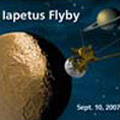 Scientists
on the Cassini mission to Saturn are poring through hundreds of images
and other data sets returned from the Sept. 10 flyby of Saturn's
two-toned moon Iapetus!
Scientists
on the Cassini mission to Saturn are poring through hundreds of images
and other data sets returned from the Sept. 10 flyby of Saturn's
two-toned moon Iapetus!
http://saturn.jpl.nasa.gov/news/events/iapetus/index.cfm
2. Days In Saturn Calculated To Be 15 Minutes Shorter
 John D. Anderson and Gerald Schubert
entitled 'Saturn's Gravitational Field, Internal Rotation, and Interior
Structure' that appeared recently in the journal Science. 'By using the
Cassini spacecraft's gravitational data, along with Pioneer and Voyager
radio occultation and wind data, we obtain a rotation period of 10
hours, 32 minutes, and 35 ± 13 seconds. This more rapid spin implies
slower equatorial wind speeds on Saturn than previously assumed, and
the winds at higher latitudes flow both east and west, as on Jupiter.'
This work was funded by NASA's Science Mission Directorate through the
Planetary Geology and Geophysics and the Planetary Atmospheres programs. You can read the full text of this article is available at Science : Saturn's Gravitational Field, Internal Rotation, and Interior Structure
John D. Anderson and Gerald Schubert
entitled 'Saturn's Gravitational Field, Internal Rotation, and Interior
Structure' that appeared recently in the journal Science. 'By using the
Cassini spacecraft's gravitational data, along with Pioneer and Voyager
radio occultation and wind data, we obtain a rotation period of 10
hours, 32 minutes, and 35 ± 13 seconds. This more rapid spin implies
slower equatorial wind speeds on Saturn than previously assumed, and
the winds at higher latitudes flow both east and west, as on Jupiter.'
This work was funded by NASA's Science Mission Directorate through the
Planetary Geology and Geophysics and the Planetary Atmospheres programs. You can read the full text of this article is available at Science : Saturn's Gravitational Field, Internal Rotation, and Interior Structure
And popular press coverage appears at:
- Space.com : Length of Saturn's Day Revised
- USA Today : Length of Saturn's day gets shorter
- NewScientistSpace : Saturn's dizzying spin hints at quick birth
Follow this link to read the perspectives piece by Morris Podolak: http://www.sciencemag.org/cgi/content/full/317/5843/1330
1. Baptistina Parent Body Killed the Dinosaurs
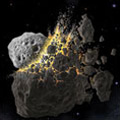 William Bottke
of SwRI who's recent article (Bottke, Vokrouhlický & Nesvorný 2007
'An asteroid breakup 160 Myr ago as the probable source of the K/T
impactor' Nature 449, 48-53) identifies 'the catastrophic disruption of
the parent body of the asteroid Baptistina' as the source for the KT
impact that killed the dinosaurs. This work was supported by NASA's Origins of Solar Systems, Planetary Geology and Geophysics, and Near-Earth Objects Observations programs. For more information see:
William Bottke
of SwRI who's recent article (Bottke, Vokrouhlický & Nesvorný 2007
'An asteroid breakup 160 Myr ago as the probable source of the K/T
impactor' Nature 449, 48-53) identifies 'the catastrophic disruption of
the parent body of the asteroid Baptistina' as the source for the KT
impact that killed the dinosaurs. This work was supported by NASA's Origins of Solar Systems, Planetary Geology and Geophysics, and Near-Earth Objects Observations programs. For more information see:
Nature : Killer asteroid fingered
Also a number of popular press articles have been written about this work including:
- NPR : Dinosaur-Killing Asteroid Traced to Breakup Event
- San Francisco Chronicle : Scientists say they know where dinosaur-killing asteroid came from
- Christian Science Monitor : On the horizon: news from the frontiers of science
- BBC : Space pile-up 'condemned dinos'
- Google News : Traced: The asteroid breakup that wiped out the dinosaurs
- The Times : How asteroid spelt doom for the dinosaurs
- Scientific America : Asteroid Smashup May Have Wiped Out the Dinosaurs
- National Geographic : Far-Flung Crash May Have Created Dino-Killer Asteroid
- and many others.
To read the abstract and/or download the full text of this article see
Nature : An asteroid breakup 160 Myr ago as the probable source of the K/T impactor

